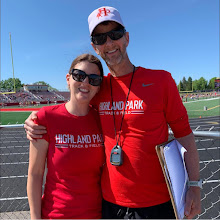In past marathon training cycles, I’ve almost exclusively followed Jack Daniels or Pete Pftizinger’s training plans. I don’t really know why I never mixed it up more. I know people who’ve had success with Kevin Beck’s program, and I have a buddy that keeps using the Hanson’s Marathon Method. I’m sure there are other programs out there, but honestly, I don’t know what the latest craze is.
As I’ve been mentioning a lot lately, I’ve been on a Matt
Fitzgerald kick lately. If you combine that with my affinity for the professional
team, NAZ Elite, you get the following list of books that I’m going to rely
heavily on for this training cycle;
Run Like a Pro (Even if You’re Slow): Elite Tools and
Tips for Runners at Every Level by Matt Fitzgerald and Ben Rosario. This
book takes Matt’s 80/20 Running program and includes some Coach’s Tips from Ben.
I really like the program, at least as it is on paper, because it focuses on
volume, but 80% of that volume is easy running. As for the other 20%, it
includes a variety of workouts that seem manageable (again, on paper). By “variety”
I mean, tempo, fartlek, hills, fast-finish, long runs w/ progression, steady-state,
leg speed, 5K and 10K pace intervals and so on.
80/20 Running by Matt Fitzgerald. This came
out years before Run Like a Pro, but I read it afterwards, so I included it
second. It’s probably not necessary to read both of them.
Running the Dream by Matt Fitzgerald. This
book follows Matt as he spends an entire 13-week training cycle in Flagstaff,
AZ as a “fake pro”. During that time, he’s coached by Ben Rosario, he works out
with NAZ Elite, and he has access to everything the pros use. Spoiler alert:
after years of training and 40+ marathons under his belt, Matt makes a huge
breakthrough. Oh yeah, he was 47 years old at the time.
Inside a Marathon: An All-Access Pass to a Top-10
Finish at NYC by Scott Fauble and Ben Rosario. This is perhaps one of
the most unique running books on the market. It follows NAZ elite athlete,
Scott Fauble, and his coach, Ben Rosario, through a 20-week training cycle
leading up to the 2018 NYC Marathon. After each week of training, both Scott
and Ben write a recap from their perspective – without the other knowing what
they wrote.
Yesterday I mentioned that my plan was to document this
18-week session as best I can – ala Running the Dream. In addition to
blogging about it, I was thinking I would add a lot more color to my Strava posts,
however, now I’m reconsidering that second part. I was listening to a podcast
with Steven Pressfield about his creative process. He mentioned that it’s bad
luck to talk about what he’s working on before it’s been released into the world.
Not that I believe all that, but most of my Strava followers are my high school
athletes, so they probably don’t need to know the details of my marathon training.
I’ll limit exposure to my dozen or so blog readers.
Quote of the day;
“The past is a memory, the future is an idea, all that exists is the moment.” – Scott Fauble, Inside a Marathon
